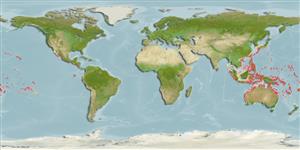Classification / Names
Common names | Synonyms | Catalog of Fishes (gen., sp.) | ITIS | CoL | WoRMS | Cloffa
Actinopterygii (ray-finned fishes) >
Ophidiiformes (Cusk eels) >
Bythitidae (Viviparous brotulas) > Brosmophycinae
Etymology: Alionematichthys: Name from Latin alius meaning the other or different, and nematichthys, the stem of the genus name Dinematichthys, to which this genus is most similar..
Environment / Climate / Range
Ecology
Marine; reef-associated; depth range 0 - 12 m (Ref. 90102). Subtropical, preferred ?
Eastern Indian Ocean to Western Central Pacific: Andaman Is. to Sumatra, Thailand, Vietnam, Taiwan and the Ryukyu Is., north to Australia (up to Lord Howe I.) and eastwards to Micronesia, Line Is., Tuamotus and Pitcairn Group.
Size / Weight / Age
Maturity: Lm ? range ? - ? cm
Max length : 8.4 cm SL male/unsexed; (Ref. 81230)
Short description
Morphology | Morphometrics
Dorsal
soft rays
(total): 72-88;
Anal
soft rays: 55 - 70;
Vertebrae: 40 - 45. This species is distinguished by the following characters: D 72-88; A 55-70; moderately large eyes (1.7-2.8%SL); slender body; blunt snout, many cirri; cheeks with scales and rarely 1-2 scales above opercular spine; with upper preopercular pore; outer pseudoclasper broad-based, large, often extending beyond hood when in resting position, while the inner one is small, with equal anterior and posterior lobes; otolith length to height 1.9-2.1, with gently curved dorsal rim; otolith length to sulcus length 1.5-1.6, ostium length to caudal length 3.5-4.5; vertebrae 11-12 + 29-33 = 40-45 (Ref. 81230).
Occurs in holes and crevices of coralline and volcanic rock (Ref. 71230). Cryptic and solitary in shallow water (<12 m) (Ref 90102).
Life cycle and mating behavior
Maturity | Reproduction | Spawning | Eggs | Fecundity | Larvae
Møller, P.R. and W. Schwarzhans, 2008. Review of the Dinematichthyini (Teleostei, Bythitidae) of the Indo-west Pacific, Part IV. Dinematichthys and two new genera with descriptions of nine new species. The Beagle 24:87-146. (Ref. 81230)
IUCN Red List Status (Ref. 115185)
CITES (Ref. 94142)
Not Evaluated
Threat to humans
Harmless
Human uses
More information
Common namesSynonymsMetabolismPredatorsEcotoxicologyReproductionMaturitySpawningFecundityEggsEgg development
Age/SizeGrowthLength-weightLength-lengthLength-frequenciesMorphometricsMorphologyLarvaeLarval dynamicsRecruitmentAbundance
ReferencesAquacultureAquaculture profileStrainsGeneticsAllele frequenciesHeritabilityDiseasesProcessingMass conversion
Tools
Special reports
Download XML
Internet sources
Estimates of some properties based on models
Phylogenetic diversity index (Ref.
82805): PD
50 = 0.5005 [Uniqueness, from 0.5 = low to 2.0 = high].
Bayesian length-weight: a=0.00447 (0.00175 - 0.01142), b=3.10 (2.88 - 3.32), in cm Total Length, based on LWR estimates for this (Sub)family-body shape (Ref.
93245).
Trophic Level (Ref.
69278): 3.2 ±0.5 se; Based on size and trophs of closest relatives
Resilience (Ref.
69278): High, minimum population doubling time less than 15 months (Preliminary K or Fecundity.).
Vulnerability (Ref.
59153): Low vulnerability (15 of 100) .
